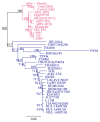Progress and challenges toward the development of vaccines against avian infectious bronchitis
- PMID: 25954763
- PMCID: PMC4411447
- DOI: 10.1155/2015/424860
Progress and challenges toward the development of vaccines against avian infectious bronchitis
Abstract
Avian infectious bronchitis (IB) is a widely distributed poultry disease that has huge economic impact on poultry industry. The continuous emergence of new IBV genotypes and lack of cross protection among different IBV genotypes have been an important challenge. Although live attenuated IB vaccines remarkably induce potent immune response, the potential risk of reversion to virulence, neutralization by the maternal antibodies, and recombination and mutation events are important concern on their usage. On the other hand, inactivated vaccines induce a weaker immune response and may require multiple dosing and/or the use of adjuvants that probably have potential safety risks and increased economic burdens. Consequently, alternative IB vaccines are widely sought. Recent advances in recombinant DNA technology have resulted in experimental IB vaccines that show promise in antibody and T-cells responses, comparable to live attenuated vaccines. Recombinant DNA vaccines have also been enhanced to target multiple serotypes and their efficacy has been improved using delivery vectors, nanoadjuvants, and in ovo vaccination approaches. Although most recombinant IB DNA vaccines are yet to be licensed, it is expected that these types of vaccines may hold sway as future vaccines for inducing a cross protection against multiple IBV serotypes.
Figures



References
-
- Schalk A., Hawn M. An apparently new respiratory disease of baby chicks. Journal of the American Veterinary Medical Association. 1931;78(413–422):p. 19.
-
- Matthijs M. G. R., Van Eck J. H. H., Landman W. J. M., Stegeman J. A. Ability of Massachusetts-type infectious bronchitis virus to increase colibacillosis susceptibility in commercial broilers: a comparison between vaccine and virulent field virus. Avian Pathology. 2003;32(5):473–481. doi: 10.1080/0307945031000154062. - DOI - PubMed
Publication types
MeSH terms
Substances
LinkOut - more resources
Full Text Sources
Other Literature Sources

